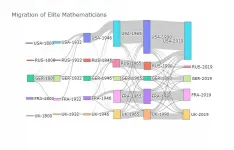(Press-News.org) As social media platforms like Instagram, Snapchat, TikTok and others continue to grow in popularity, adolescents are spending more of their time online navigating a complex virtual world.
New research suggests that these increased hours spent online may be associated with cyberbullying behaviors. According to a study by the University of Georgia, higher social media addiction scores, more hours spent online, and identifying as male significantly predicted cyberbullying perpetration in adolescents.
"There are some people who engage in cyberbullying online because of the anonymity and the fact that there's no retaliation," said Amanda Giordano, principal investigator of the study and associate professor in the UGA Mary Frances Early College of Education. "You have these adolescents who are still in the midst of cognitive development, but we're giving them technology that has a worldwide audience and then expecting them to make good choices."
Cyberbullying can take on many forms, including personal attacks, harassment or discriminatory behavior, spreading defamatory information, misrepresenting oneself online, spreading private information, social exclusion and cyberstalking.
The study surveyed adolescents ranging in age from 13-19 years old. Of the 428 people surveyed, 214 (50%) identified as female, 210 (49.1%) as male, and four (0.9%) as other.
Exploring social media addiction
When adolescents are online, they adapt to a different set of social norms than when they're interacting with their peers in person. Oftentimes, they are more aggressive or critical on social media because of the anonymity they have online and their ability to avoid retaliation. Additionally, cyberbullies may feel less remorse or empathy when engaging in these behaviors because they can't see the direct impact of their actions.
"The perpetrator doesn't get a chance to see how damaging their bullying is and to learn from their mistakes and do something different," said Giordano. "It's a scary situation because they don't have the natural consequences they do with offline bullying."
Teenagers who are addicted to social media are more likely to engage in cyberbullying, as well as those who spend more time online. Participants in the study reported spending on average over seven hours online per day, and the reported average maximum hours spent online in one day was over 12 hours.
"Social media addiction is when people crave it when they're not on it, and continue their social media use despite negative consequences," said Giordano. "Some negative consequences could be they're tired during the day because they're scrolling all night long, they're having conflicts with their parents, they're getting poor grades in school or they're engaging in actions online that they later regret, but they still continue to use social media."
Social networking sites are designed to give people a dopamine hit, she added, and some people compulsively look for that hit. "It's feeding into that addictive behavior, and they may be using cyberbullying as a way to get likes, shares, comments and retweets," she said. "That's the common thread you see in behavioral addictions--people start relying on a rewarding behavior as a way to make them feel better when they're experiencing negative emotions. And so, I think the social media addiction piece is really interesting to show that there's another factor at play here in addition to the number of hours spent online."
The study also found that adolescent males are more likely to engage in cyberbullying than females, aligning with past studies that show aggressive behaviors tend to be more male driven. More research on the socialization process of men can help determine what's leading them to engage in more cyberbullying behaviors.
Next steps for counselors and clinicians
Giordano believes that counselors need to start assessing adolescents for social media addiction if they are engaging in cyberbullying and to provide treatment plans to help redefine their relationship with technology. These interventions may include helping adolescents examine how they define their self-worth and restricting the amount of time they spend on social media platforms.
"There's quite a few strong and reliable assessments for social media addiction for adolescents that have good psychometric properties," said Giordano. "I think when clinicians see cyberbullying happen, they really need to explore the individual's relationship with social media and to address social media addiction, not just the cyberbullying."
Often, school counselors are not aware of cyberbullying until after an incident occurs. To address this issue, Giordano recommends that schools start educating students earlier about cyberbullying and social media addiction as a preventive method instead of waiting to repair the damage. Whether it's through an awareness campaign or support group, schools can help students talk about cyberbullying to give them a chance to understand the consequences of their actions and prepare them for potential risks.
"We need schools and school counselors to do this preventative work early and educate students about the risk of addiction with some of these rewarding behaviors like gaming and social media," said Giordano. "We need to teach them the warning signs of behavioral addiction, what to do if they start to feel like they're losing control over their behaviors and help them find other ways to manage their emotions, rather than turning to these behaviors. There are a lot of programs already moving in this direction, and I think that's amazing and there needs to be more of it."
Counselors can help decrease the risk of some of these addictive behaviors at a young age by teaching and equipping children with emotional regulation skills and other ways to cope with their feelings.
"If you think about it, adolescents are not only figuring out who they are offline, but they're also trying to figure out who they want to be online," said Giordano. "We're giving them even more to do during this developmental period, including deciding how they want to present themselves online. I think it's a complex world that we're asking adolescents to navigate."
INFORMATION:
Math's top prize, the Fields Medal, has succeeded in making mathematics more inclusive but still rewards elitism, according to a Dartmouth study.
Published in Nature's END ...
Researchers at the Johns Hopkins Kimmel Cancer Center used machine learning techniques to detect mutational signatures in cancer patients. Their algorithm outperformed the current standard of analysis and revealed new mutational signatures associated with obesity, which is believed by cancer prevention experts to be becoming the most significant lifestyle factor contributing to cancer in the U.S. and most of the Western world.
The study was published in the Jan. 25 issue of the journal eLife.
"Mutational signatures are important in current cancer research as they enable you to see the signs left by underlying factors, such as aging, smoking, alcohol use, UV exposure, and BRCA inherited mutations that contribute to the development ...
Making people fear the coronavirus may motivate us to wash our hands, keep our distance and wear a face mask. But fear also takes a heavy toll on our mental health and is fertile ground for discrimination and prejudice. New research shows a different path.
When the coronavirus pandemic hit the world in the spring of 2020, feelings of being capable or efficacious against the virus were a key factor in driving compliance with the authorities' guidelines. This is the result of a new study based on large surveys across eight Western democracies, published in British Journal of Health Psychology.
The extent to which we personally felt informed and capable of acting clearly affected the extent of our behaviour to prevent infection, e.g. by keeping our distance ...
A team of researchers at the Technical University of Munich (TUM) has developed a new early warning system for vehicles that uses artificial intelligence to learn from thousands of real traffic situations. A study of the system was carried out in cooperation with the BMW Group. The results show that, if used in today's self-driving vehicles, it can warn seven seconds in advance against potentially critical situations that the cars cannot handle alone - with over 85% accuracy.
To make self-driving cars safe in the future, development efforts often rely on sophisticated models aimed at giving cars the ability to analyze the behavior of all traffic participants. But what happens if the models are not yet capable of handling some complex ...
Drinking beetroot juice promotes a mix of mouth bacteria associated with healthier blood vessels and brain function, according to a new study of people aged 70-80.
Beetroot - and other foods including lettuce, spinach and celery - are rich in inorganic nitrate, and many oral bacteria play a role in turning nitrate to nitric oxide, which helps to regulate blood vessels and neurotransmission (chemical messages in the brain).
Older people tend to have lower nitric oxide production, and this is associated with poorer vascular (blood vessel) and cognitive (brain) health.
In the new study, by the University of Exeter, 26 healthy older people took part in two ten-day supplementation periods: one with nitrate-rich ...
Increasing numbers of people in Belgium are turning away from meat in favour of plant-based alternatives, according to new research from psychologists at the University of Bath, in collaboration with Belgian animal welfare organisation GAIA.
New analysis finds that in 2020, over half of Belgians (51%) were 'satisfied' with meat alternatives - a figure that has increased from 44% since 2019.
The results of the research which gauged responses from a representative sample of 1,000 people in Belgium over two years (in 2019 and 2020) highlights concerns around animal agriculture and the environment that are impacting individuals' dietary choices.
Additional findings from ...
Computer scientists at the University of Surrey have created a ground-breaking model that could improve our understanding of developmental disorders such as autism.
Scientists have long tried to better understand how the cerebral cortex and its layers develop, with pathologies such as autism, schizophrenia and epilepsy linked to this process.
In a paper published by the journal Cerebral Cortex, scientists from Surrey, Newcastle University, and Nottingham University detail how they developed and used a computational model to simulate cell division, cell migration and apoptosis (cell death) in the hope of understanding how these processes affect the development of the brain.
With the help of their computer model, the ...
A study examining bean productivity among smallholder farmers in Tanzania, has found that on average, yields are 6% lower among female than male farmers. Women are often 'invisible' in agriculture, researchers say, due to social structural barriers and national agricultural policies, which do not address discriminatory land rights; education and agricultural information and decision making, which must be tackled to reverse this trend.
The paper 'What Does Gender Yield Gap Tell Us about Smallholder Farming in Developing Countries?' published in the open access scientific journal Multidisciplinary Digital Publishing (MDPI), analyzed data from southern region in Tanzania since 2016 and also drew on research ...
'A transmissible cancer was first discovered in dogs in the middle of the 19th century. It is transmitted sexually from a sick dog to a healthy one, the cancer cells themselves being the infective agent. In the 1990s, a contagious cancer was discovered in the Tasmanian devil. Since the cancer was found in only two species of mammals, scientists used to think that it is quite rare in the nature. However, time has come to reconsider this view. A transmissible cancer appears to be fairly widespread among bivalve molluscs,' says Maria Skazina, a research associate at the ...
DALLAS - March 30, 2021 - UT Southwestern researchers have identified factors that put patients with childhood-onset lupus at elevated risk for poor outcomes, such as end-stage renal disease or death, as they transition from pediatric to adult health care. The findings, published online in Seminars in Arthritis and Rheumatism, emphasize the precarious nature of this period and shine a spotlight on areas prime for intervention to help protect these vulnerable patients.
Patients with chronic diseases that used to be fatal early in life now often survive to live long lives. However, says study senior author END ...




